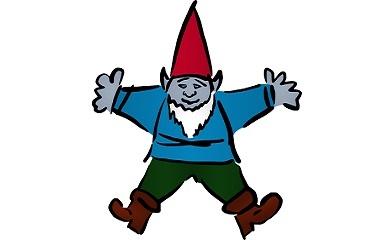What is a Gnome?
A Gnome is a small creature with an affinity for the earth. In old legends, these little men were miners who lived underground. Today, they have come out of their tunnels to help humans tend to their gardens.
Characteristics
Physical Description
Thanks to the garden gnome industry, you probably have an automatic idea of what a “gnome” looks like. Gnomes are small men with short arms and legs and round cheeks and bellies. They have light skin and white beards, large noses and friendly smiles that make their cheeks puff out. To complete their charming, earthy look, Gnomes wear bright colored tunics, usually green, yellow, or blue, with a wide belt and contrasting leggings. And, of course, a Gnome is never fully dressed without his dunce-cap, which is usually bright red.
This iconic image of Gnomes has been around since the 1800s, but if you do a little digging, you’ll unearth the Gnome’s original look. It’s quite different! The original Gnome was a small, ugly creature who lived underground. A wild being, he paid little attention to hygiene, and he certainly didn’t wear the colorful tailored clothes that Gnomes today are so fond of!
Personality
The very first written account of Gnomes describes them as “very reluctant to interact with humans,” which could explain why they liked to live in burrows underground. The Gnome’s elusive nature has lasted throughout the ages. Even the cute and cuddly gnomes of today have a reputation for being shy, which is why they are often found peeking out from behind plants, with a bashful grin.
Ancient Gnomes, who lived underground, were often associated with mines and wealth. They were thought to be the guardians of golden treasure, and they had great wisdom, not only about mining the earth, but also about managing money in general. Advice from a Gnome could make any man rich.
Today, Gnomes have surfaced from their mines, and they can be found wandering woodland areas or hiding out in old gardens. Their days in the mines taught them to be hard-working and responsible, so they can still take on a “guardian” role in their forest or garden, protecting their territory and helping out when possible.
Of course, Gnomes have also become more light-hearted since they emerged from their dark mines. Many of them have developed mischievous streaks, and they enjoy popping out of unexpected places or playing silly pranks—like dropping their britches in public!
Special Abilities
Gnomes have a special connection to the earth. In fact, they were once considered “earth elementals,” meaning that they could travel through earth as easily as humans travel through air. To this day, they are believed to enrich garden soil, making vegetables and flowers flourish.
Some Gnomes are capable of speech, while others are not. The Gnomes who do speak are known to be clever with jokes and riddles.
Cultural Representation
History
Gnomes were first introduced by Paracelsus, a 16th century alchemist who believed that these little creatures were earth elementals. For the next three centuries, Gnomes continued to be underground, so to speak. They were mostly discussed by alchemists and obscure mythological scholars.
During the 19th century, Gnomes began to creep into the public awareness. At first, they were used as the opposite of fairies—ugly, earthy, and backwards creatures, where fairies were beautiful, ethereal, and graceful. But, by the end of the 19th century, the public had embraced Gnomes. They appeared as quaint, helpful creatures in children’s stories, and Garden gnomes were already being mass produced to delight adults.
Modern Appearances
Despite its slow and obscure beginning, the Gnome has become a staple in modern fantasy. These little creatures pop up in Oz as underground businessman; in Narnia as underground slaves; in Tolkein’s Middle Earth as talented miners of gemstones, and in JK Rowling’s wizarding world as common garden pests.
Gnome Controversy
With their bright colors and affable smiles, Gnomes might seem like the least likely mythical creature to spark a debate. In fact, these little men are a flashpoint for several controversies!
First, they have been banned from several gardening competitions, since they are considered inelegant and childish. The backlash has been huge, with Gnome-supporters accusing the gardeners of being snobbish and classist.
Second, they are often “gnome-napped” from gardens. Originally, gnome-nappings were committed by friends of the family who owned the gnome. The gnome-napper would then travel with the gnome, taking pictures of it in various locations before returning it with a photo album of its “vacation photos.” In recent years, gnome-napping has escaladed. Strangers have begun abducting Gnomes, which has led to charges of breaking-and-entering and theft. Organized “gnome liberation groups” have even sprung up around the world. Gnomes who are taken by the liberators are never returned to their homes. Instead, they are “released” into their natural habitat, usually a forest or park.











“They don’t appear to be hostile, but the stench is unbearable and they emit a bloodcurdling scream at night.”
Dr. Nildur Krelt-Gnomeologist
I got a little xmas decoration that looks like the pic on the first screen! all hair and just his little nose peeking out under his bright red pointy cap!